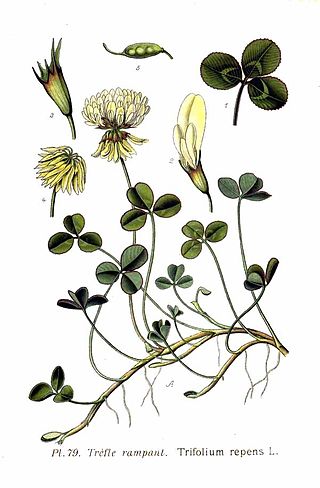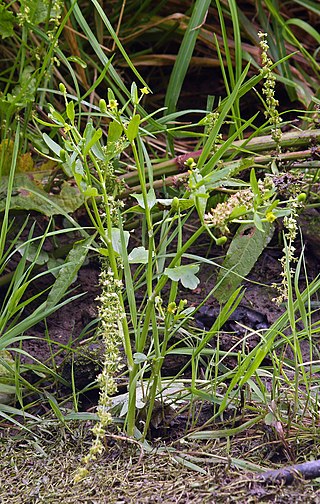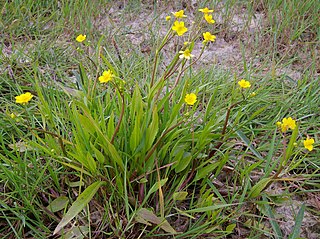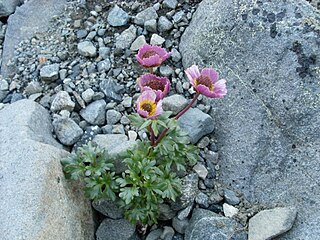
Clover, also called trefoil, are plants of the genus Trifolium, consisting of about 300 species of flowering plants in the legume family Fabaceae originating in Europe. The genus has a cosmopolitan distribution with highest diversity in the temperate Northern Hemisphere, but many species also occur in South America and Africa, including at high altitudes on mountains in the tropics. They are small annual, biennial, or short-lived perennial herbaceous plants, typically growing up to 30 centimetres (12 in) tall. The leaves are trifoliate, with stipules adnate to the leaf-stalk, and heads or dense spikes of small red, purple, white, or yellow flowers; the small, few-seeded pods are enclosed in the calyx. Other closely related genera often called clovers include Melilotus and Medicago.

Ranunculaceae is a family of over 2,000 known species of flowering plants in 43 genera, distributed worldwide.

Lupinus, commonly known as lupin, lupine, or regionally bluebonnet etc., is a genus of plants in the legume family Fabaceae. The genus includes over 199 species, with centers of diversity in North and South America. Smaller centers occur in North Africa and the Mediterranean. They are widely cultivated, both as a food source and as ornamental plants, but are invasive to some areas.

Ranunculus is a large genus of about 1700 to more than 1800 species of flowering plants in the family Ranunculaceae. Members of the genus are known as buttercups, spearworts and water crowfoots.
There are over 190 vascular plant species on the Norwegian Arctic archipelago of Svalbard. This figure does not include algae, mosses, and lichens, which are non-vascular plants. For an island so far north, this number of species constitutes an astonishing variety of plant life. Because of the harsh climate and the short growing season, all the plants are slow growing. They seldom grow higher than 10 cm (4 in)

Ranunculus glacialis, the glacier buttercup or glacier crowfoot, is a plant of the family Ranunculaceae. It is a 5-10(-20) cm high perennial herb. Often with a single relatively large flower, with 5 petals first white later pink or reddish. The underside of the 5 sepals are densely brown-hairy. The leaves are fleshy, shiny, and deeply loped, forming 3 leaflets. Ranunculus glacialis reported to have a diploid chromosome number of 2n = 16.

Ranunculus bulbosus, commonly known as bulbous buttercup or St. Anthony's turnip, is a perennial flowering plant in the buttercup family Ranunculaceae. It has bright yellow flowers, and deeply divided, three-lobed long-petioled basal leaves.

Packera is a genus of about 75 species of plants in the daisy family, Asteraceae. Most species are commonly called ragworts or grounsels. Its members were previously included in the genus Senecio, but were moved to a different genus based on chromosome numbers, a variety of morphological characters, and molecular phylogenetic evidence.

Astereae is a tribe of plants in the family Asteraceae that includes annuals, biennials, perennials, subshrubs, shrubs, and trees. They are found primarily in temperate regions of the world. Plants within the tribe are present nearly worldwide divided into over 250 genera and more than 3,100 species, making it the second-largest tribe in the family behind Senecioneae.

Idol Densetsu Eriko is a Japanese anime series by Ashi Productions. It ran in Japan from 1989 until 1990, spanning 51 episodes. The story has been adapted into a 3-volume manga series by Ayumi Kawahara. The title character Eriko is based on real-life Japanese idol Eriko Tamura, who performs the opening theme song and the last episode's ending theme.

Ranunculus sceleratus known by the common names celery-leaved buttercup, celery-leaf buttercup, and cursed buttercup is a species of flowering plant in the buttercup family Ranunculaceae. It has a circumpolar distribution in the northern hemisphere, native to temperate and boreal North America and Eurasia, where it grows in wet and moist habitats, including ponds and streambanks.

Ficaria is a small genus of several species of plants in the family Ranunculaceae, which were previously grouped with Ranunculus. The genus includes Ficaria verna, known as fig buttercup or lesser celandine, and related species. The name "Ficaria" is Classical Latin for fig. Plants in the genus are closely related to true buttercups, but generally have only three sepals and swollen smooth achenes.

Ranunculus flammula, the lesser spearwort, greater creeping spearwort or banewort, is a species of perennial herbaceous plants in the genus Ranunculus (buttercup), growing in damp places throughout the Boreal Kingdom. It flowers June/July. Ranunculus flammula is poisonous. It is very closely related to R. reptans, which is distinguished by prostrate and more slender stems, narrower leaves and smaller flowers and is sometimes included within R. flammula sensu lato as a variety.

Ranunculus auricomus, known as goldilocks buttercup or Greenland buttercup, is a perennial species of buttercup native to Eurasia. It is a calcicole typically found in moist woods and at the margins of woods. It is apomictic, and several hundred agamospecies have been recognised.

Beckwithia is a genus of plants of the family Ranunculaceae. Most botanists consider it synonymous to a clade consisting of Ranunculus glacialis and Ranunculus andersonii. B. glacialis has several distinct forms that may also be considered subspecies or closely related species. However, molecular studies have supported the placement of B. glacialis and B. camissonis within Ranunculus, distant from B. andersonii.
Callianthemoides is a genus of plants in the family Ranunculaceae, with a single species, Callianthemoides semiverticillata. Native to screes in northern Patagonia, it has divided greyish or reddish green leaves and large white or pink flowers.
The Botany of Fuegia, the Falklands, Kerguelen's Land, Etc. is a description of the plants discovered in these islands during the Ross expedition written by Joseph Dalton Hooker and published by Reeve Brothers in London between 1845 and 1847. Hooker sailed on HMS Erebus as assistant surgeon. It was the second in a series of four Floras in the Flora Antarctica, the others being the Flora of Lord Auckland and Campbell's Islands (1843-1845), the Flora Novae-Zelandiae (1851–1853), and the Flora Tasmaniae (1853–1859). They were "splendidly" illustrated by Walter Hood Fitch.

Halerpestes is a genus of flowering plants belonging to the family Ranunculaceae.
Ranunculus luminarius is a species of flowering plant in the family Ranunculaceae, native to Italy. It is a member of the Ranunculus auricomus complex.















